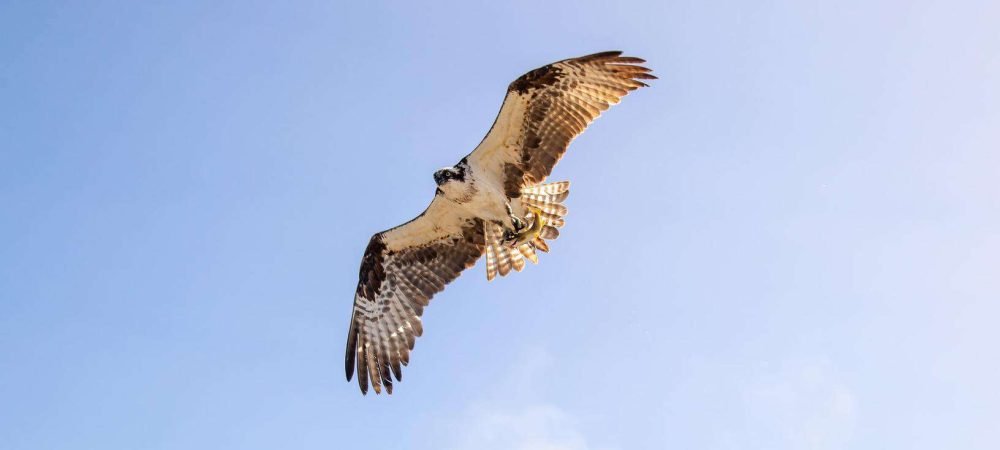
Want to learn more? This book on the Birds of Prey of North America is a fantastic read!
With a nickname like ‘Big Sky Country’, you’d expect Montana to be a place where birds thrive.
It doesn’t disappoint, housing over 420 bird species in its deep forests and mountains. An abundance of protected lands like Yellowstone and Glacier National Parks makes Montana an even better refuge for birds-of-prey like the hawk.
The following is a list of all hawks in the U.S. state of Montana, with some information about how to spot one of them:
Want to attract birds of prey to your yard? Take a look at our article!
What Hawks can be seen in Montana?
Table of Contents
1. Sharp-Shinned Hawk
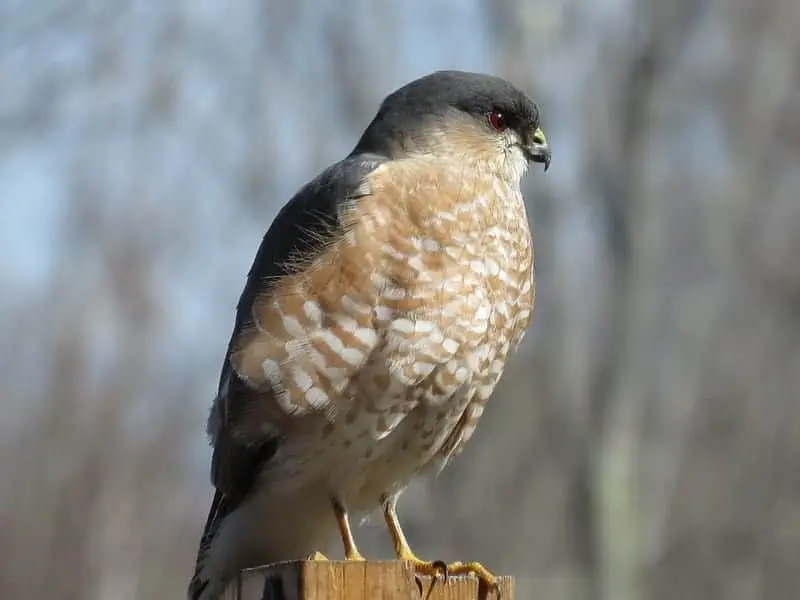
“Sharp-Shinned Hawk” by ‘Dennis Murhpy‘ is licensed under CC BY 2.0
Frank Lambert, XC274807. Accessible at www.xeno-canto.org/274807.
Wingspan
43-56cm
Weight
87-218g
Life Expectancy
3 years
Diet
Robins and Thrushes
The smallest of the American hawk family, the sharp-shinned hawk hunts other birds from atop the tall trees like the conifers of Montana’s many forests.
They can often be spotted on the outskirts of forests, seeking critters running across the open plains.
Its back and feathers are a dark gray that might appear black to the naked eye, while its underside is usually mixed between an off-white and different shades of red and brown.
The sharp-shinned hawk remains in-state year round migrating from the mountains and the northern reaches to the lowland south in August, which is an ideal time to catch them grouped in flight, or resting between trips.
2. Cooper’s Hawk
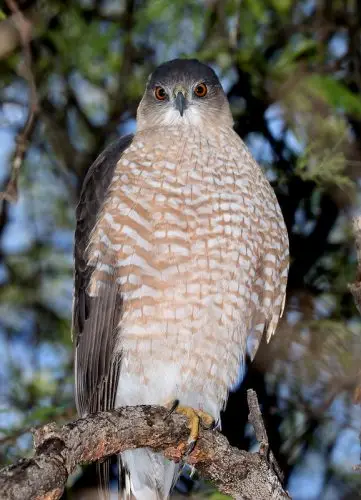
Sue Riffe, XC611811. Accessible at www.xeno-canto.org/611811.
Wingspan
62-90cm
Weight
330-680g
Life Expectancy
Up to 12 years
Diet
Small Birds, Mice & Squirrels
This larger version of the sharp-shinned hawk–their plumage has the same dark colors on the back and light hues on the underbelly– is another one that likes to make meals of other birds.
In fact, Cooper’s hawks can become a bit of a nuisance for people who use feeders to attract their less-ravenous kin, but this also creates opportunities for ambitious birdwatchers to catch a glimpse without leaving their backyards.
When they’re not preying on bird feeders, Cooper’s hawks hunt around edges of tall pine forests, over riparian areas like those found near Montana’s Fish Creek.
Like most hawks, they fly to the lowlands in the winter, to places like Bozeman, Montana.
3. Northern Goshawk
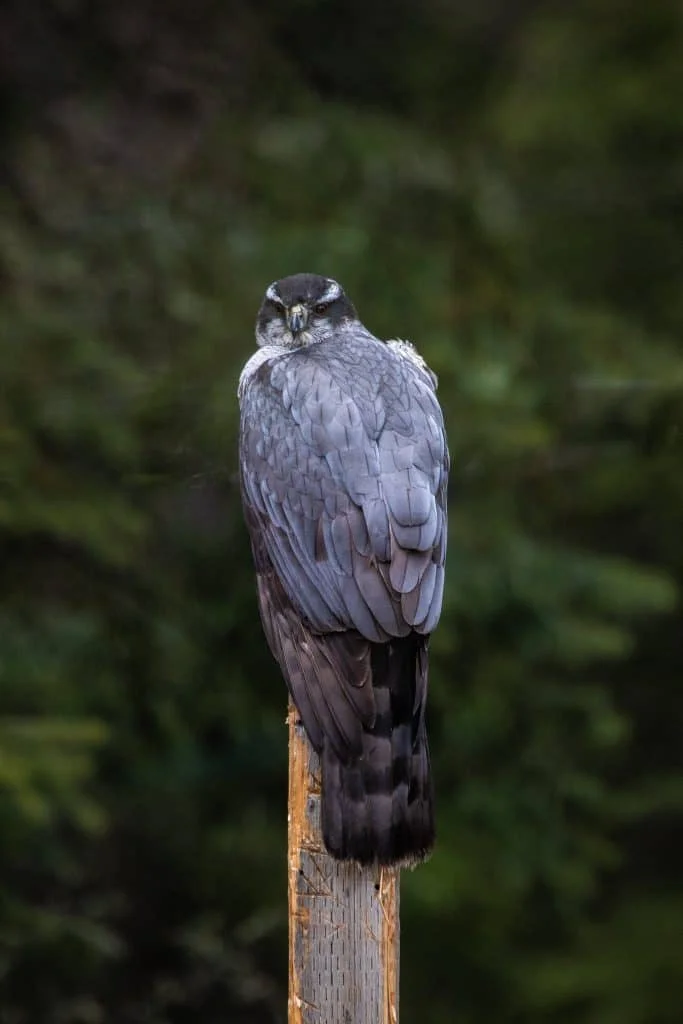
Peter Stronach, XC623479. Accessible at www.xeno-canto.org/623479.
Wingspan
89-127cm
Weight
631-1364g
Life Expectancy
7 Years
Diet
Mammals, reptiles & insects
The northern goshawk is another hawk that lives in Montana year-round. It is physically one of the more distinctive of the hawk family, with the front-side a speckled or checkered white and dark, while its back and wings are a shade of dark grey.
Many have even darker coloring around the eyes, giving the appearance of a’ bandit’s mask, usually topped with a white stripe that resembles an eyebrow.
As these hawks operate in the shadows of the forest, spotting one is more challenging than the others.
Also, they don’t follow the usual migration patterns of other hawks, as their winter location depends on the movement of food sources rather than temperatures.
Still, the bird does tend toward lowlands when it’s cold.
Based on the geography of Montana, your chances of spotting one are likely higher.
The goshawk is also not picky about which type of forest it inhabits, as specimens have been spotted in the scattered forest to the east as well as the dense pines of the southwest like Beaverhead County.
4. Broad-Winged Hawk
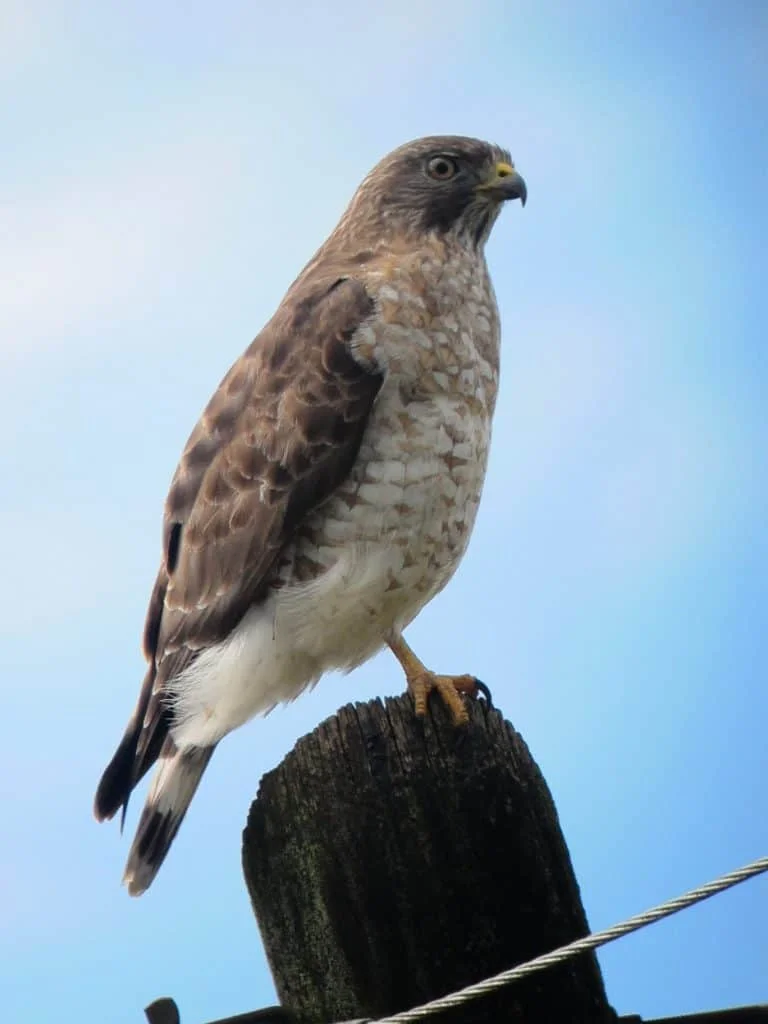
“Broad Winged Hawk” by ‘Felipe Uribe‘ is licensed under CC BY 2.0
Meena Haribal, XC479508. Accessible at www.xeno-canto.org/479508.
Wingspan
81-100cm
Weight
265g-560g
Life Expectancy
Up to 20 years
Diet
Small mammals & insects
The broad-winged hawk hangs out near the edges of forest-like most hawks, except it avoids human contact more than others.
As the name indicates, these raptors are recognizable by their broad wings, which spread like fingers in full flight.
The color morphs of the broad-winged hawk range between shades of brown from earth tones to near-black, with off-white checkered patterns that are usually checkered with browns and grays, with a thick white line on their tails.
The broad-winged hawk is famous for its migrations, called ‘kettles’, wherein enormous flocks of them on their way to Central America in the winter.
Like many US states, this is the ideal time to catch a broad-winged hawk in Montana.
5. Swainson’s Hawk
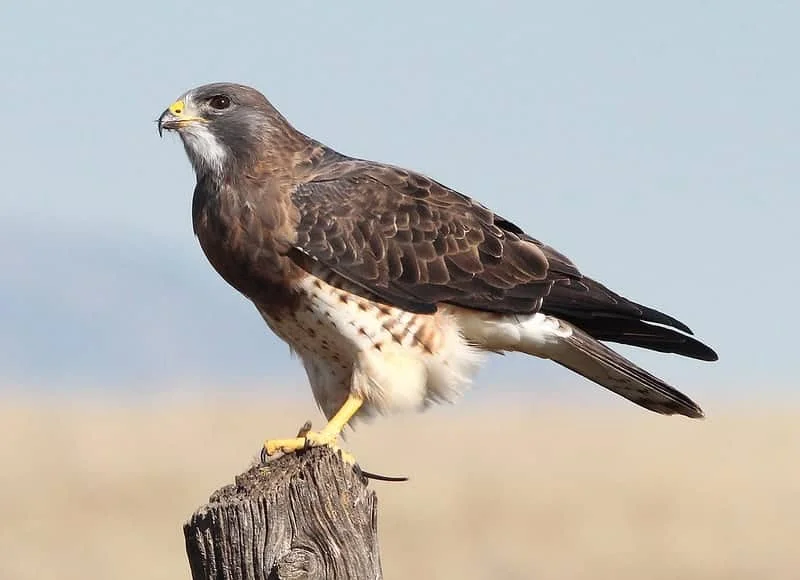
Bruce Lagerquist, XC468974. Accessible at www.xeno-canto.org/468974.
Wingspan
4 feet
Weight
693-1367g
Life Expectancy
16-19 years
Diet
Mammals & Insects
This is another ‘roadside raptor’ that is comfortable in civilizations, often perching on man-made structures like fences and signs.
In Montana, the Swainson’s hawks gather in lowland places where isolated trees act as hunting towers from which they nest and travel for miles a day before returning.
Outside of the pale lined patterns typically found on the bottom side of their wings, these hawks can come their feathers may vary from light-brown to dark rust, with hues so dark as to appear black near the wing tips.
Their chests and faces are usually lighter shades of browns and grays, giving some contrast between the front and rear of the bird, like many hawks.
It frequents Montana in the summer, where groups can be seen settling in after winter migrations took them as far away as Argentina.
6. Red-Tailed Hawk
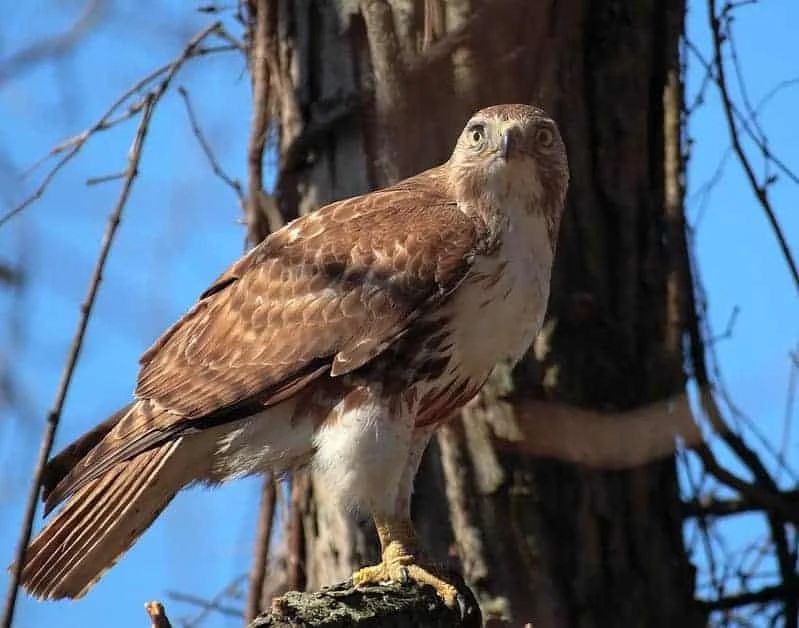
Peter Ward and Ken Hall, XC603736. Accessible at www.xeno-canto.org/603736.
Wingspan
114-133cm
Weight
900-1460g
Life Expectancy
10-15 years
Diet
Small mammals, mice & voles
The red-tailed hawk gatherers in most of the tree-laden places in the U.S., so Montana’s towering pines and rich waterways are likely buffets to this large raptor.
They are spotted by their trademark red tails, which may vary according to their coloring from shades close to orange to deep reds.
The rest of the red-tailed hawk varies too much in composition–from whitish-grey to brown and red–to be of any real use in identification.
However, the bird can be identified by its size, as the red-tail is one of the largest hawk species in the US averaging 2.5 pounds in weight with a four-foot wingspan.
It’s not an exaggeration to say these hawks can be found everywhere in the state during warmer months, from the deep woods to tall buildings to all the neighborhoods between, and most likely remain there during the winter.
7. Rough-Legged Hawk
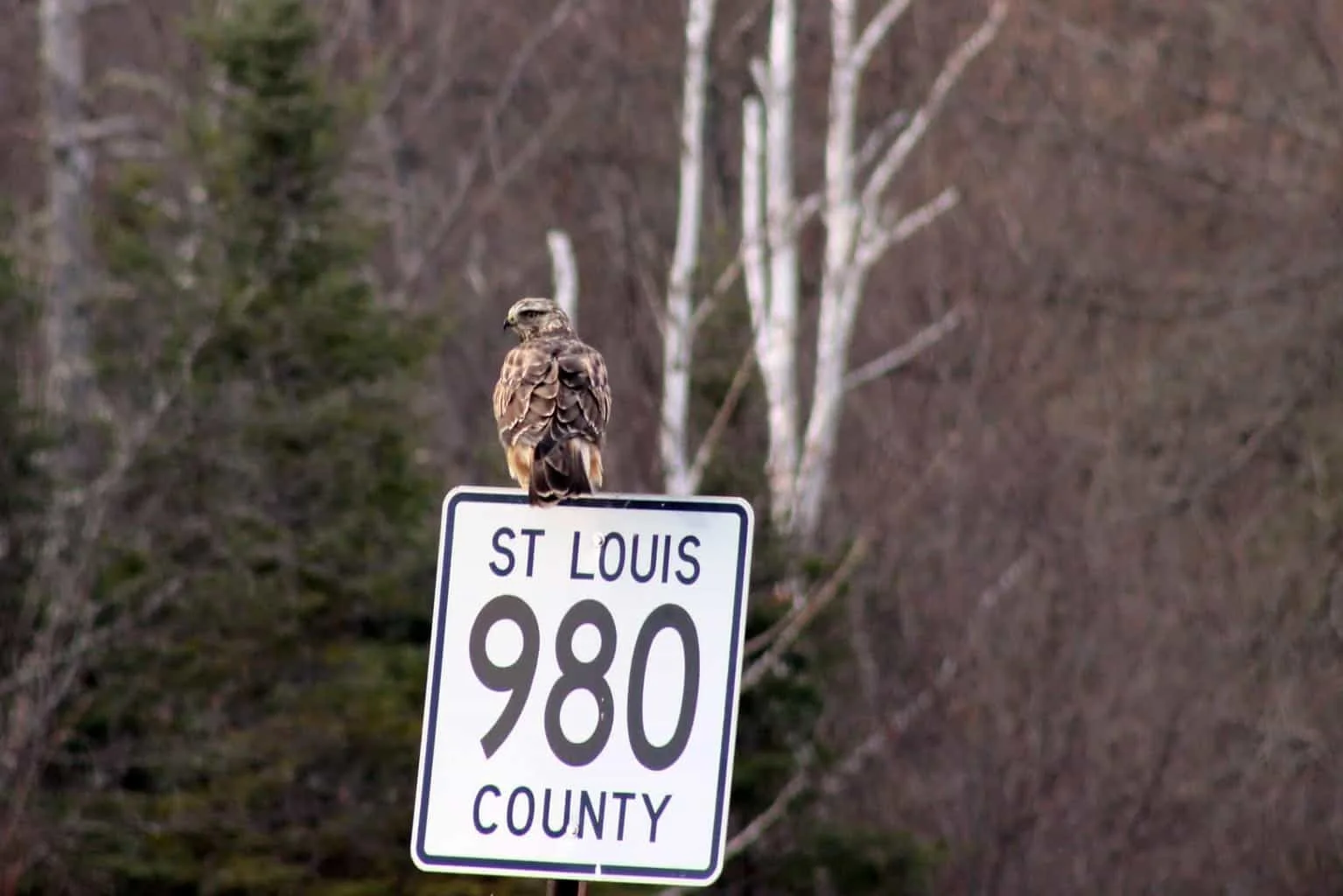
Stein Ø. Nilsen, XC580104. Accessible at www.xeno-canto.org/580104.
Wingspan
132-138cm
Weight
715-1400g
Life Expectancy
Up to 18 years
Diet
Small rodents
Following the spot-on naming conventions of the red-shouldered and sharp-shinned hawks, the rough-legged hawk has a unique relationship with Montana.
As the bird ranges into Canada in the warm seasons, it settles in places like Montana’s Mission Valley when it flies south.
This makes the winter the ideal time to spot a rough-legged hawk at rest in Montana, unlike all the other hawks, who are either spotted in spring and summer or caught moving in the fall.
Its distinctive name comes from the fact its legs are covered with feathers, giving them a ‘rough’ appearance compared to the smooth, featherless legs of most other birds.
They are recognized by their distinctly pale undersides–including the bottom of their wings–that bleed into slightly darker back and wing feathers.
Their crowns may be the same off-white paleness of their undersides, or they may be a continuation of the different shades of brown on their backs.
8. Ferruginous hawk
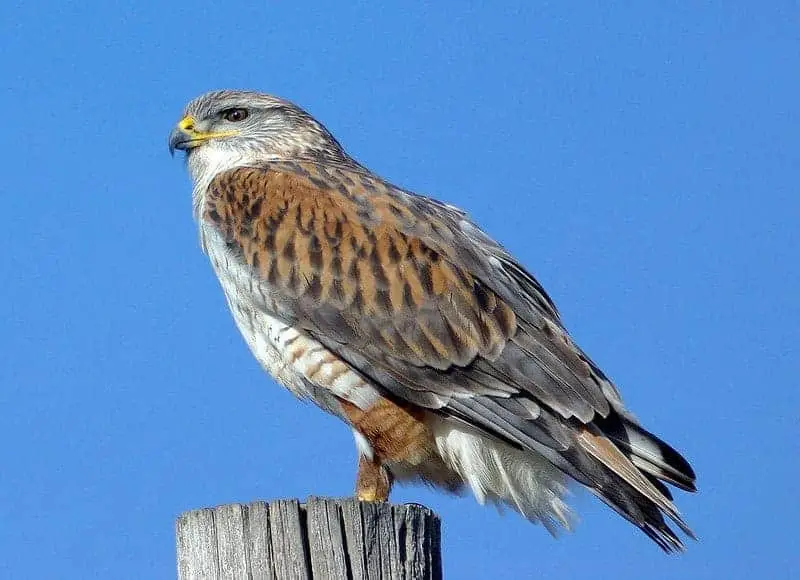
Paul Marvin, XC419204. Accessible at www.xeno-canto.org/419204.
Wingspan
133-142cm
Weight
977-2074g
Life Expectancy
16-20 years
Diet
Small mammals
These are the largest of the North American hawks. The word ‘ferruginous’ is an old Latin term that means ‘dark red; rust colored’, which should clue you in on the most distinctive part of this raptor’s appearance.
However, while their backs and wings are always a shade of rust (or reddish-brown), the undersides of ferruginous hawks vary.
Those with pale undersides are commonly spotted, while the darker varieties are quite rare.
Their nesting and hunting grounds vary just as widely, from lowland sagebrush to conifer canopies to mountainous outcroppings, hunting other birds and critters as large as rabbits.
9. Northern Harrier
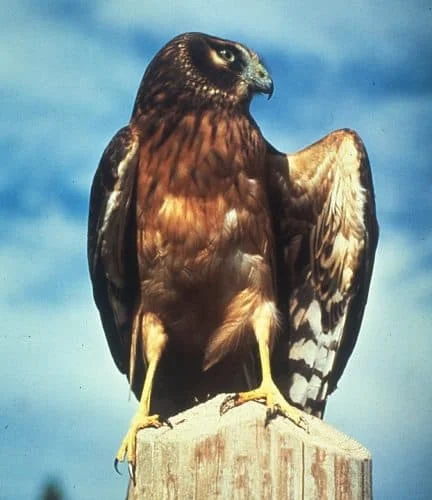
Bruce Lagerquist, XC329772. Accessible at www.xeno-canto.org/329772.
Wingspan
120cm
Weight
390g
Life Expectancy
16 years
Diet
Rodents and small birds
This ‘owl-like’ member of the hawk family is perhaps the most adaptable to lowland hunting.
Not that the northern harrier can’t thrive among the trees, but its approach to hunting requires no perch, so most of them build their nests on the ground.
Their facial discs stand out at their most identifying characteristic; like owls, northern harriers have a ring of hardened, discolored feathers around the face.
Their circular heads and stout bodies do more for the image, but the extrusion of the beak is a bit more pronounced than their look-alikes.
Males are grey with light undertones on the stomach and chest; females vary in shades of brown.
They are spring breeders, who can be spotted most frequently in March, and again in the fall when the weather starts to cool and they migrate south.

More Articles.
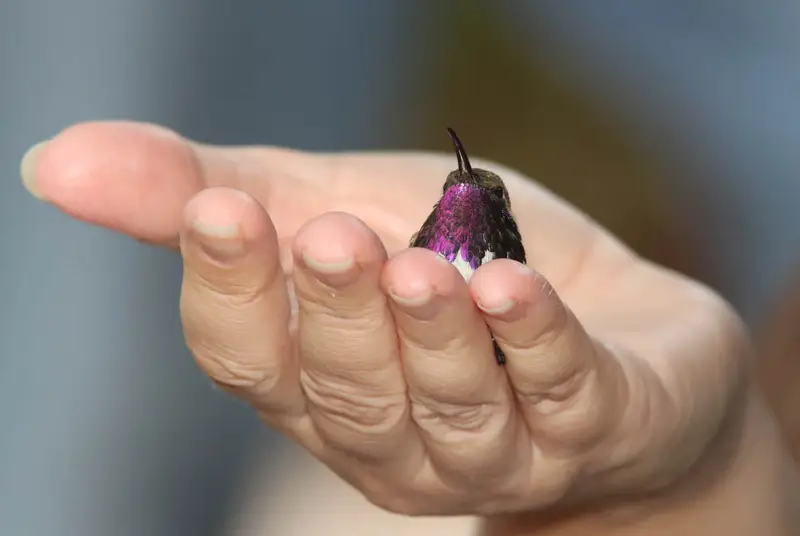
Can you keep a Hummingbird as a Pet in the US?
In the US, it is in fact illegal to keep hummingbirds as pets in your
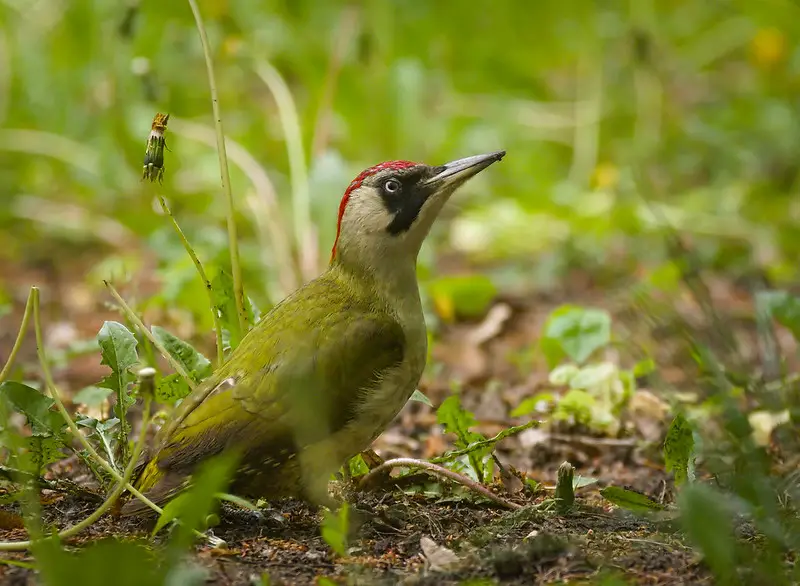
What Woodpeckers can you see in France? (9 Species with Pictures & Sounds)
What woodpeckers can you see in France? There are 9 different species of woodpecker that
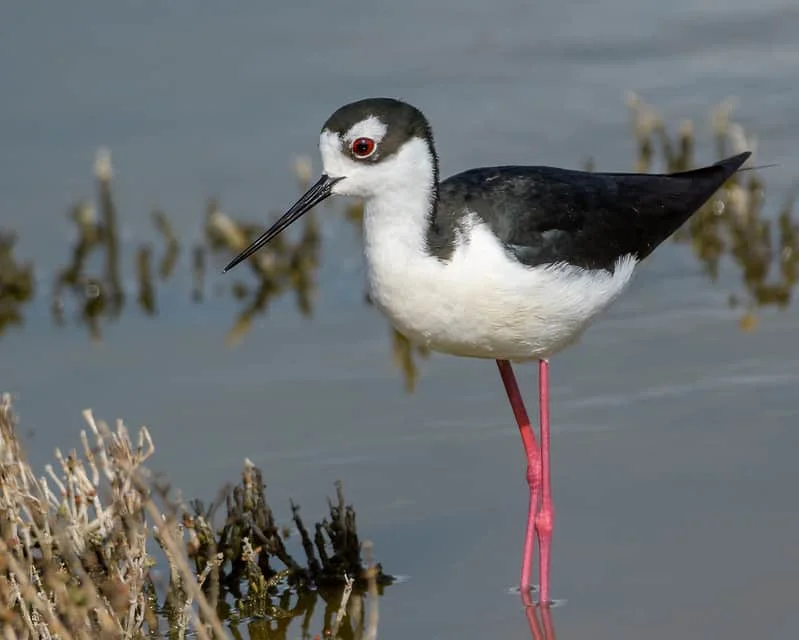
North American Birds with Red Feet (14 Species with Sound and Pictures)
North America is filled with many wonderful birds with red feet – in fact, there

About Us
We are avid bird-watchers who recently retired, allowing us more time to travel the world. Fortunately, we have managed to visit numerous countries around Europe, Asia, and America. Watching and photographing birds has been a passion for many years and we are making the most of the extra time on our hands!
